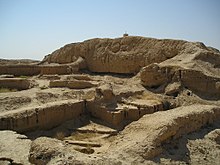تل حريري (in Arabic) | |
 Ruins of Mari | |
| Alternative name | Tell Hariri |
|---|---|
| Location | Abu Kamal, Deir ez-Zor Governorate, Syria |
| Coordinates | 34°32′58″N 40°53′24″E / 34.54944°N 40.89000°E |
| Type | Settlement |
| Area | 60 hectares (150 acres) |
| History | |
| Founded | c. 2900 BC |
| Abandoned | 3rd century BC |
| Periods | Bronze Age |
| Cultures | East-Semitic (Kish civilization), Amorite |
| Site notes | |
| Archaeologists | André Parrot |
| Condition | Ruined |
| Ownership | Public |
| Public access | Yes |
Mari (Cuneiform: 𒈠𒌷𒆠, ma-riki, modern Tell Hariri; Arabic: تل حريري) was an ancient Semitic city-state in modern-day Syria. Its remains form a tell 11 kilometers north-west of Abu Kamal on the Euphrates River western bank, some 120 kilometers southeast of Deir ez-Zor. It flourished as a trade center and hegemonic state between 2900 BC and 1759 BC.[note 1] The city was built in the middle of the Euphrates trade routes between Sumer in the south and the Eblaite kingdom and the Levant in the west.
Mari was first abandoned in the middle of the 26th century BC but was rebuilt and became the capital of a hegemonic East Semitic state before 2500 BC. This second Mari engaged in a long war with its rival Ebla and is known for its strong affinity with Sumerian culture. It was destroyed in the 23rd century BC by the Akkadians, who allowed the city to be rebuilt and appointed a military governor (Shakkanakku). The governors became independent with the disintegration of the Akkadian Empire, and rebuilt the city as a regional center of the Euphrates valley. The Shakkanakkus ruled Mari until the second half of the 19th century BC, when the dynasty collapsed for unknown reasons. A short time later, Mari became the capital of the Amorite Lim dynasty. The Amorite Mari lasted only a short time before it was destroyed by Babylonia in c. 1761 BC, but it survived as a small settlement under the rule of the Babylonians and the Assyrians before being abandoned and forgotten during the Hellenistic period.
The Mariotes worshiped both Semitic and Sumerian deities and established their city as a major trading center. Although the pre-Amorite periods were characterized by heavy Sumerian cultural influence, Mari was not a city of Sumerian immigrants but a Semitic-speaking nation with a dialect similar to Eblaite. The Amorites were West Semites who began to settle the area before the 21st century BC; by the Lim dynasty (c. 1830 BC), they became the dominant population in the Fertile Crescent.
Mari's discovery in 1933 provided an important insight into the geopolitical map of ancient Mesopotamia and Syria, due to the discovery of more than 25,000 tablets explicating the state administration in the 2nd millennium BC and the nature of diplomatic relations among the political powers of the region. They also revealed the wide trading networks of the 18th century BC, which connected areas as far as Afghanistan in Southern Asia and Crete in the Mediterranean.
Cite error: There are <ref group=note> tags on this page, but the references will not show without a {{reflist|group=note}} template (see the help page).

